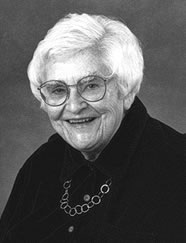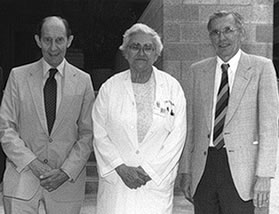Dr. Bunn is Professor, Department of Medicine, at Harvard Medical School, and Staff Physician, Division of Hematology, at Brigham and Women’s Hospital.
Dr. Helen Ranney is among the most distinguished physician-scientists in academic medicine. She was the first female chairperson of a department of medicine in the United States and the first female president of both the Association of American Physicians and the American Society of Hematology. She is also a member of the National Academy of Sciences.
Dr. Ranney was born and raised on a dairy farm in New York and, in her view, benefited greatly by early education in a one-room schoolhouse. Her upbringing imbued her with a strong sense of responsibility and the importance of working with her own two hands, qualities which were key determinants of her later success in research.
To fully appreciate Dr. Ranney’s career, one must not only focus on her impressive accomplishments but also look at the obstacles she overcame. After graduating from Barnard College, the women’s affiliate of Columbia University, Dr. Ranney hoped to enter Columbia’s College of Physicians and Surgeons (P&S) but found that gender bias made access difficult. She bided her time working in a research laboratory until the United States’ entrance into World War II suddenly brought openings at P&S for qualified women applicants. The director of the research laboratory, Dr. Donovan McCune, not only inspired Dr. Ranney’s lasting interest in medical research, but strongly supported her application for admission to P&S where she completed her medical school and residency training. Influenced in part by a strong biochemistry department that included a cadre of brilliant biochemists who had fled Europe to work at Columbia, she became enamored with this discipline. Her early scientific development was also fostered by interactions with Drs. David Rittenberg, Salome Waelsch (mouse geneticist), Reinhold and Ruth Benesch, Irving London, Ernst Jaffé and, later, Paul Gallop.
Dr. Ranney stands with Dr. Oscar Ratnoff to her left and Dr. Samuel Rapaport to her right.
Dr. Ranney stands with Dr. Oscar Ratnoff to her left and Dr. Samuel Rapaport to her right.
In 1953, Dr. Ranney began to work on hemoglobin in what was to be a career-long inquiry. Most of her research was done single-handedly or with the help of only a lab assistant or post-doctoral fellow. She showed that the isolated α and ß subunits of hemoglobin had high affinity for oxygen and lacked cooperativity, thus differing markedly from native tetrameric human hemoglobin. A few years earlier, Drs. Harvey Itano and Linus Pauling reported the separation of normal and sickle hemoglobin by the cumbersome technique of moving boundary electrophoresis. Dr. Ranney was the first to apply the much more practical and accessible technique of paper electrophoresis to the separation of human hemoglobins. Synergy between her biochemical expertise and her clinical acumen enabled her to identify both common and rare hemoglobin variants and establish the genetic basis for their inheritance. She was the first to show that Hb S and Hb C are allelic, thereby elucidating the inheritance pattern of hemoglobin SC disease. In those days, physiology trumped biochemistry as the fashionable discipline for clinical investigators. Despite a remarkable record of research contributions early in her career, this mind-set and perhaps her gender delayed Dr. Ranney’s entry into the American Society for Clinical Investigation. Nevertheless, when finally admitted, she was still among the first women to receive this accolade.
In 1960, Dr. Ranney moved from Columbia to the newly developing Albert Einstein College of Medicine where she founded a cross-disciplinary heredity clinic. She oversaw the training of an outstanding group of academic hematologists, including Drs. Robert Bookchin and Ronald Nagel, who have remained at Einstein and made landmark contributions in sickle cell disease. With Dr. Sam Rahbar, she demonstrated the utility of Hb AIc for monitoring patients with diabetes, and over a 20-year period she explored the interactions of hemoglobin with the inner surface of the red cell membrane.
While continuing her research, Dr. Ranney continues to be a highly respected and revered clinician and teacher. Her prowess and comfort in all three components of medical academe made her a compelling choice to assume the chair of the Department of Medicine at University of California, San Diego, for 13 years. Throughout this time and up to the present, she has placed a high premium on nurturing the careers of deserving junior colleagues.
Attendees pause for a photo at the 25th annual meeting. In the back, from left to right, are Drs. C. Lockard Conley, Ernest Beutler, and Ernst Jaffé. In front, from left to right, are Drs. John Harris, Helen Ranney, and Samuel Rapaport.
Attendees pause for a photo at the 25th annual meeting. In the back, from left to right, are Drs. C. Lockard Conley, Ernest Beutler, and Ernst Jaffé. In front, from left to right, are Drs. John Harris, Helen Ranney, and Samuel Rapaport.
Dr. Ranney’s impact on academic medicine and hematology rests in no small part on the force of her personality. She is widely known for her uncanny ability to size up people and to trouble-shoot complex interpersonal and institutional problems. She is well known for her acerbic wit and disarming candor. Like Bernard Shaw, she jests in earnest. She once famously described a distinguished but rather pompous senior professor as "all that oil but no machinery." She expressed concern that a hyperambitious junior colleague was "overselling his goods." Her magnetism is based on a no-nonsense style and avoidance of self-promotion. Once at a Plenary Session at an ASH annual meeting, her chair slipped and she fell over the back of the platform. Those of us who were in the audience remember our collective sense of relief when we saw her hand rise above the platform with a "V" for victory sign. She attributes her subsequent success as ASH President to widespread sympathy from the large audience. Dr. Ranney is refreshingly modest about her research accomplishments, pointing out that "if we hadn’t done it, it would have been done some years later by someone else. We’re not Bach, who, had he not lived, the music would never have been written."
An exemplar of the physician-scientist, Dr. Ranney has achieved iconic status as a role model for medical academicians in general and for hematologists and women in particular.




